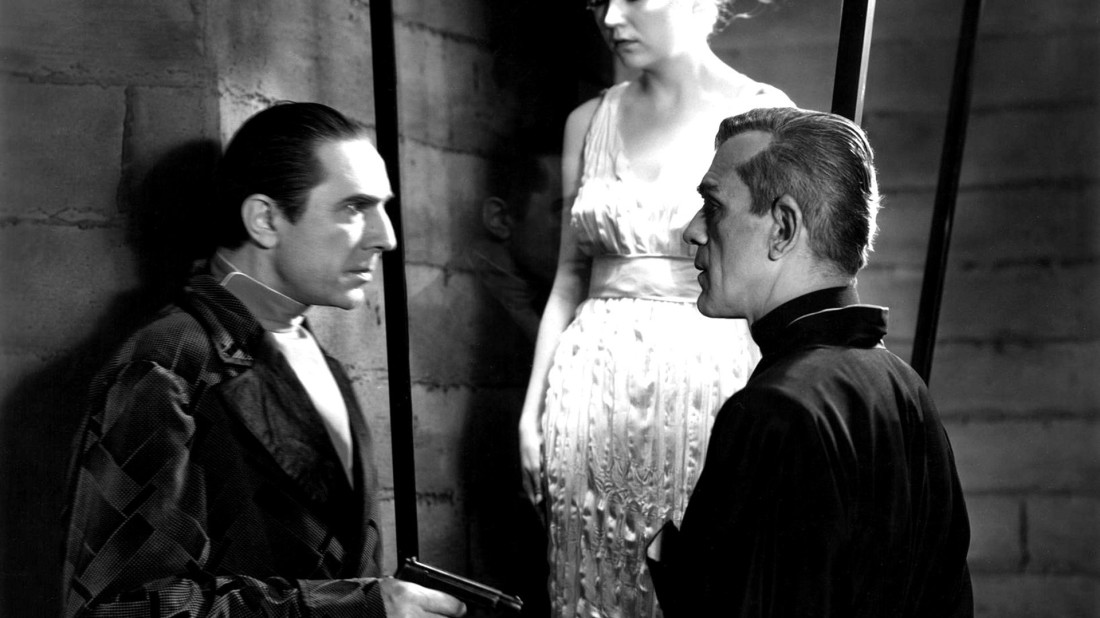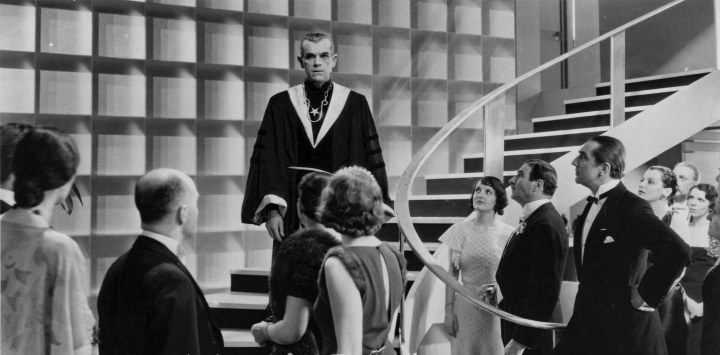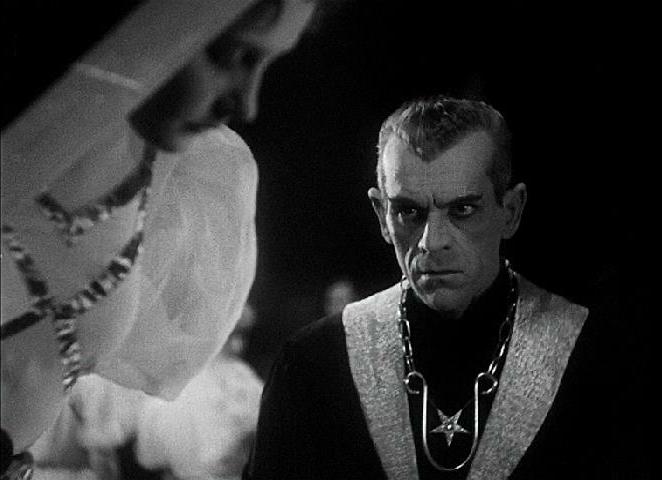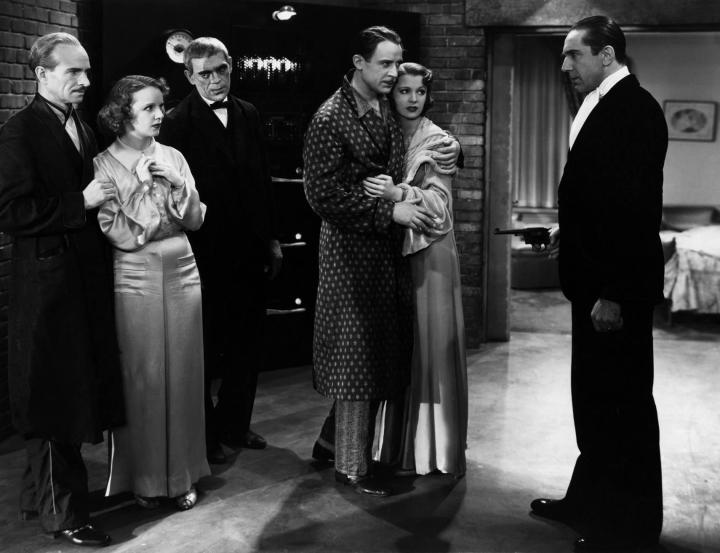I am pretty certain that I have loved Edgar G. Ulmer’s The Black Cat longer than any other film. That means about 50 years. Oh, I’d loved the movies — especially older horror movies — in a broad sense, but The Black Cat was the first film I realized was something special. I had no real idea how it was special — and the idea of a director having something to do with it hadn’t even entered my head at that point. (It would take repeated viewings of the then-available three James Whale horror films to cause that penny to drop in the slot.) There isn’t even any way I could have really understood the story. I just knew it was different — and it looked and sounded terrific. In fact, it was the single greatest factor in striking an interest in classical music. The dividends it has paid over the years are incalculable.
The Black Cat is unquestionably the better film of this duo. In fact, it’s one of those horror movies that completely transcends the genre to simply be a great film on any basis. Everything about the film is beautifully controlled and brilliantly executed. The screenplay is as witty as it is dark, with its tale of a honeymooning mystery novelist (David Manners) and his wife (Jacqueline Wells). The couple become unwitting pawns in a game of death between an embittered and slightly unhinged psychiatrist (Lugosi) and the wholly evil leader (Karloff) of a Satanist cult. The acting is very fine. (This is almost certainly Lugosi’s best performance.) The all-classical musical score put together by director Edgar G. Ulmer and musical director Heinz Roemheld is perfect (and launched a generation of classical music fans). And then there’s the nonstop creativity of the direction itself. It had to be creative, since there was very little money available. (The entire train station opening is lifted from the 1932 British film Rome Express and many of the impressive-looking sets are painted flats.) There really is nothing quite like it.
I’ve spent years dissecting The Black Cat and writing about it—in far more detail than I can possibly undertake here. Let me just say that it’s a film with unusually deep characterizations for both its stars. Lugosi’s betrayed and long-suffering Dr. Vitus Werdegast (returning from 15 years in a Russian prison, thanks to the Karloff character’s traitorous actions during World War I) is particularly fine—even, on occasion, deeply moving. Moreover, it’s a horror film that stands the traditional trappings of the genre on their head, since the bulk of the action takes place in the nightmarishly sleek, Bauhaus-inspired home of the treacherous Hjalmar Poelzig (Karloff), where even the Satanic altar has been given the modernist treatment. (That last probably helped sidestep the censors in terms of an inverted crucifix!)
Louis Friedlander’s The Raven is something else again. Friedlander was promoted to this film from serials — and presumably because Ulmer fell out of favor with the studio for running off with the wife of one the owner’s relatives. Otherwise, Ulmer as director of The Black Cat — supposedly Universal’s biggest moneymaker of 1934 — would have been back. Friedlander’s background shows. Where everything was style on top of style in The Black Cat, here the stylistic flourishes are few and far between, limited to a clever camera angle here and there with a basic stand-‘em-up-and-shoot-‘em mindset more in evidence. As filmmaking, it’s nicely competent—most of the time. (It probably cannot be blamed on Friedlander that the credits mix up the roles being played by Ian Wolfe and Spencer Charters, and it’s unlikely he chose to re-use the music from The Black Cat andWerewolf of London (1935) for most of the film.)
The biggest thing The Raven has going for it is Lugosi. It is pretty much all his film — and the only film ever to afford him that special last-name-only billing they were giving Karloff at the time. (At least that’s true on the credits. The posters still went with “Bela (DRACULA) LUGOSI” — a measure of just how typecast that one role made him.) This is Lugosi at his most lip-smacking evil in a story that not only allows him to go over the top, but demands it. And no one could go over the top as well as Lugosi. Top-billed Karloff didn’t stand a chance — and always derided the film. There’s no denying that it’s silly stuff. This, after all, is a movie where Lugosi just happens to have an operating room with six mirror — with remote controlled curtains — arranged so that Karloff will empty his gun into them when he gets a look at his new face. (Why Lugosi didn’t just take the gun from him while he was operating on him is a separate question.) But it’s divinely silly stuff.









I especially love the taste of German Impressionism in The Black Cat. I also live in fear of it being colorized.
I doubt it. I think colorization is pretty much dead.
The Black Cat may be my favorite Lugosi film (and high up on the Karloff list too). As an aside, I ordered the Blu Ray box set of Universal Monsters Essential Collection, with eight films. According to all reviews I’ve read, the video quality leaves every other version, including the Legacy series (and the Legacy Anniversary versions) in the dust. Oddly, the region-free UK Blu Ray box set costs a lot less than the U.S. version but has the same discs and extras. It will be better than Christmas when they arrive.
Perhaps these films will eventually be released on Blu Ray as well. I hope so.
The Blu-ray set is mighty fine. I happened to get the US set cheap on sale at a bargain. My only qualm about UK discs is the slight speed-up that comes from the PAL to NTSC conversion. Most times I can’t tell it, but it’s very noticeable on the UK My Little Chickadee. Why, I do not know.
I’ve had an all-region, PAL to NTSC DVD player for a while now and have a number of region 2 PAL discs that have all played fine. I wasn’t able to discern any change in the speed, so any that occured were slight indeed. As for the US version, I was surprised to see so many reviews (mostly on Amazon but a couple of other places too) complaining about the discs, indicating that they were prone to glitches, freezing up and so forth. The UK versions don’t seem to have those problems.
I’m not sure I really want to see wires and strings when I view the BR version of ‘The Invisible Man’ but I guess that is what HD reveals, according to reviews. But on the up side, there’s Julia (Julie) Adams in HD in ‘Black Lagoon…’
I got my first region-free player in 2005 and I’ve only really noticed the speed thing on that one disc. It may be something about Mae West’s voice that makes it noticeable. The speed change while mostly imperciptible is there. The Devils should run 111 min., but with the convert runs about three minutes shy of that.
Never had any trouble with the US discs freezing up or anything. Also don’t remember seeing wires in Invisible Man, but I wasn’t looking for them. A lot of things have become more obvious over the years as prints have just gotten better. What we saw from 16mm TV prints when we were kids looked very different, especially on those 1960s TVs. I’d never noticed that the “wall” Harry Corder collapses against in The Black Cat is very obviously painted canvas till the VHS tape from 35mm in the 1980s.
That’s about when I bought my player, and as mentioned, never noticed any change. I probably have 20 or so titles that are region 2, but I changed my player’s code to accept all regions. Since I’ve not received my blu ray box set yet, I can only go by what a few reviewers noted. I do recall seeing the wires holding up the Martian war machines in the original War of the Worlds for the first time not too many years ago and I found it distracting.
Regardless, I am really excited to get these upgraded versions. I hope the sequels will be also released on blu ray eventually. They may not be ‘classics’, but Universal has put them out in different iterations in the past, so I expect they will here as well.
Right now, the non-monster films are being treated pretty shabbily. The Black Cat, The Raven, Murders in the Rue Morgue, The Invisible Ray, Secret of the Blue Room, etc. have been relegated to the Universal Vault series — MOD DVD-Rs. The Lugosi titles are actually a little better than the heavily compressed ones in the so-called “Franchise Collection” from a few years ago, which managed to cram The Black Cat, The Raven, Murders in the Rue Morgue, The Invisible Ray, Black Friday onto one two-sided disc. Of course, Warner Archive has started putting out BR MOD copies of some titles.
I have that “Franchise Collection”, and it’s a pity it wasn’t spread out on two discs without the compression. Still, I find it watchable. I do wonder if those films (and other lesser known titles) are deemed to be as marketable as would the classic monster sequeals.
It seems that MOD is becoming more the norm, both with DVDs, BR discs and CDs (which I still buy frequently). I’m not sure these things should be priced comparably to commercially produced ones as they are, but if you want them…
You don’t really appreciate how much better the commercial DVDrs are than the things you copy off TCM until you make frame grabs from them. I definitely am happy to pony-up $15-20 for them. Clearly the non-monster titles don’t have the identification thing going for them that the basic monsters do. Even Werewolf of London and Dracula’s Daughter and Son of Dracula are given short shrift. The basics may one day all get the BR treatment, though they’ve recently repackaged everything as a single collection on DVD. But putting them on BR and doing the kind of restoration this first BR set did are not the same thing. And probably Universal doesn’t see a burning call to restore a Ghost of Frankenstein
Er, I see I mispelt ‘sequels’. Oops.
And ‘Mispelled’.
I saw that massive, 30-film DVD collection. I can do without the Abbott and Costello stuff. Actually, I only consider Son of Frankenstein and Werewolf of London to be the most worthy of BR release, but that’s just one opinion. Those are the only two titles other than the classic films that I will pull out on occasion, whereas the other titles only very rarely.
It’s something how these films remain ever popular. It’s great that new generations continue to discover them and keep them alive.
I would go BR on all the original Laemmle era stuff — Dracula through Dracula’s Daughter. The later stuff…not so much. And my choices are rather fringe-ish — Man Made Monster, The Strange Case of Dr. Rx, Night Monster aren’t going to be big sellers. Anything after House of Dracula, I have zero interest in. I have never even pulled The Creature from the Black Lagoon out of its sleeve and probably never will. No matter how good it looks, it’s still the same dumb movie.
What surprises and pleases me is that most of the old horrors — not just the Universals — still play well with an audience — and to a much younger audience than your or me. I find it interesting that the much newer Hammer and AIP films hold up less well for younger viewers than these 80+ year old movies.
” I have never even pulled The Creature from the Black Lagoon out of its sleeve and probably never will. No matter how good it looks, it’s still the same dumb movie.” Yes it is, but it has a certain nostalgic appeal for me, having seen it in 3D when I was a kid. I actually prefer the similar (but lower budget, I guess) ‘Monster of Piedras Blancas’.
As for the older films holding up better for younger audiences than recent Hammer and AIP films, they hold up better for me as well. I’ve not been too impressed with the new stuff from Hammer in particular.
I haven’t seen Piedras Blancas in pushing 50 years, so I’m not weighing in on it. I was in my teens when I saw Black Lagoon — and on TV — and it mostly bored me.
I would not call the new stuff from “Hammer” really Hammer. Someone just bought the name in the peculiar belief that it had market value, which, outside of the Hammer fanatics, seems pretty dubious. I did like The Woman in Black, but that’s about it. Still it’s no more a Hammer Film than Dracula Untold qualifies as a Universal horror.